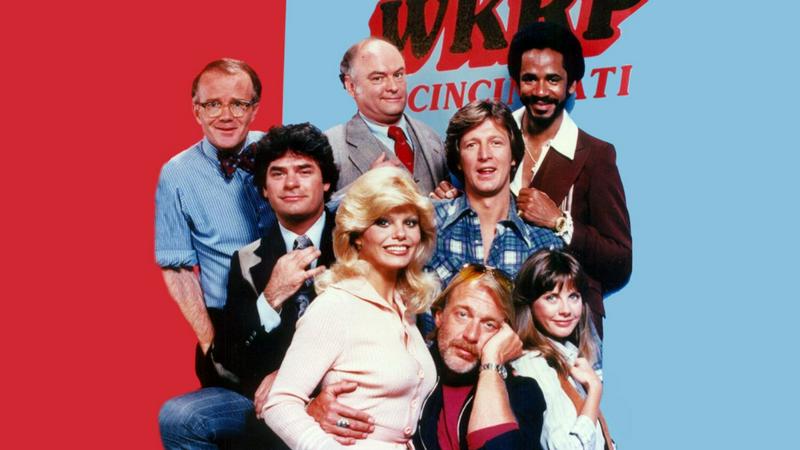WKRP In Cincinnati: When Radio Was On TV
By | October 4, 2021

WKRP in Cincinnati was a delightful combination of music, sight gags, funny situations, and quirky characters. It humanized these odd-balls working in a radio station, helped to get new bands noticed, and kept us entertained all at the same time.
Hugh Wilson created WKRP in Cincinnati based on his experiences working in advertising sales at WQXI, a top 40 radio station. He once told The Cincinnati Enquirer that he used the call sign to stand for C-R-A-P, and he based many of the characters and some of the stories on things that happened while he worked there. The premise of the show was that Andy Travis, the station’s new program director (Gary Sandy), is trying to remake the radio station and bolster ratings by changing the format from easy listening to rock and roll. Travis acts as the straight man presiding over the eccentric staff. Travis was based on Mikel Herrington, a DJ and innovative radio programmer.

The Station's Manager Prefers To Hide
The general manager of the station, Arthur Carlson (Gordon Jump) is the son of the station’s owner, Mama Carlson. He is an indecisive and bumbling manager, and his management style is a reason for the station’s struggles. He is also kind and occasionally wise, although he is often in his office, hiding from people.

The DJs
Dr. Johnny Fever (Howard Hesseman) is the DJ who ends up at WKRP after being fired from his former job at a Los Angeles radio station after he says “booger” on air although this is definitely not the last time he gets in trouble. He is an occasional insomniac and drinks an inordinate amount of coffee. His real name is John R. Caravella, but after Travis told him to change the format of the morning show, he quickly adopted the “Fever” moniker, but he also goes by other names, which are written on his mug. In the pilot, he is the host of the morning and afternoon shows, and keeps looking at his mug to keep his name straight. Hesseman was not the original choice for the role, however; the role first went to David Cassidy, who turned it down. The evening DJ is Venus Flytrap (Tim Reid), a smooth talker whose real name is Gordon Sims. He is a Vietnam War deserter and worked as a high school teacher.

Bandages And Bowties
The Station’s news reporter, Les Nessman (Richard Sanders), wears a bowtie, approaches his job with the utmost seriousness, and is quite incompetent. He fixates on agricultural news, marks off his desk with masking tape to indicate the “walls” of his office, and is staunchly patriotic. In the first episode, he had to wear a bandage over a small cut, and from then on, he wore a bandage in different places, which seemed to work with his clumsy character.
Loni Anderson plays the receptionist, Jennifer Marlowe. She is the highest-paid employee, and may be “eye candy,” she is wise and handles most situations with equanimity. She also doesn’t type (although she is quite capable), nor does she bring coffee to any of the staff. She is consistently pursued by Herb Tarlek (Frank Bonner), the sales manager. Tarlek dresses in loud plaid suits, and one of his suits was taken from the seat covers of an old Volkswagen. Incidentally, in one of the episodes, Venus Flytrap remarks, "Somewhere out there there's a Volkswagen with no seats." one of his catch-phrases is “no problemo.”

The Challenge To Les Nessman
The other prominent female in the cast was Bailey Quarters, played by Jan Smithers. She is originally responsible for billing and traffic. She eventually has other responsibilities and proves herself to be more capable than Les Nessman.

The Connection To Music
According to sources, the show played nearly 300 songs over the course of its run and adding to the success of bands like U2, Devo, the Cars, and Toto. Blondie donated a gold record to the show after they played “Heart of Glass,” helping the band’s album, Parallel Lines, to become gold. The opening theme is about Travis and was written by Hugh Wilson.
The station was decorated with items sent in by DJs around the country, and, after John Lennon was shot in 1980, a picture of him was included in the background for the remaining episodes.

The End Of An Award Winning Sitcom
The show premiered on September 18, 1978, on CBS. It ran for four seasons and a total of 90 episodes. Unfortunately, the network shifted its airtime around, which contributed to its decline in ratings and eventual cancellation. During its run, received 10 Emmy nominations, which included three for Outstanding Comedy Series; in season three, Andy Ackerman won an Emmy for Videotape Editing. It also won a Humanitas Prize, which is essentially a Nobel Prize for television. After its cancellation, it went into syndication and became one of the most popular sitcoms in syndication. From 1991-1993, they created a reboot of the series.
